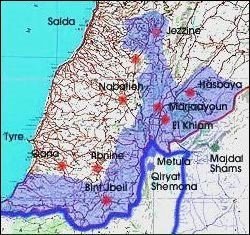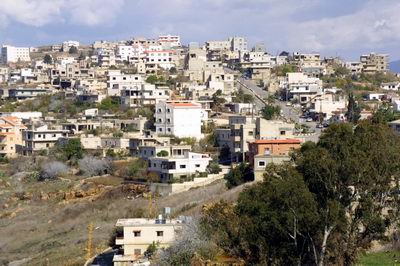Op Eds
"The population of the "security zone" was about 150,000 counting the district of Jezzine; and its local forces were about 3,000 strong. the make up of the population was Christian, Shia and Druse with some Sunni villages to the East. To their north Hezbollah had massed its forces backed by Iranian Pasdaran advisors."
 |
| Southern Lebanon's 'Security Zone' facing off with Hezbollah until 2000 |
 |
| Marjeyun and Qolaia, the largest two population centers in the "security zone" until 2000. |
Today is the 10th anniversary of the Israeli withdrawal from southern Lebanon, from what was known then as a "security zone." During that winter-spring discussions were underway at the UN by Lebanese NGOs to equip southern Lebanon with its own local force under international auspices to replace the Israeli forces, which were potentially to withdraw from the area. The idea was to provide protection to the populations of the borders areas from an advance by Hezbollah all the way to the international demarcation lines. Such takeover by the Jihadist militia would provoke an exodus by thousands of civilians who would be subjected to Hezbollah's persecution. However suddenly on May 23, the Israeli Government then under Prime Minister Ehud Barak ordered a quick pull out from the security zone without waiting for the local force, at the time known as 'South Lebanon Army' (SLA) to be transferred under the United Nations or to operate as a local force to stop Hezbollah until the UN would decide what to do.
The population of the "security zone" was about 150,000 counting the district of Jezzine; and its local forces were about 3,000 strong. the make up of the population was Christian, Shia and Druse with some Sunni villages to the East. To their north Hezbollah had massed its forces backed by Iranian Pasdaran advisors. Between 1984 and 2000 Hezbollah launched several offensives against the SLA positions but was unable to overrun them permanently. Evidently Israel's Airforce and artillery provided the strategic counter balance. However in its ground attacks, Hezbollah would reach the SLA positions only to be driven back later. The southern Lebanese militaries were trained by the Israelis but knew the Hezbollah's tactics first hand as they hailed from the same villages and had learned the tricks. Hezbollah most lethal weapon were the suicide attacks but in a local intra-Lebanese fight, suicide bombing doesn't work. The southern Lebanese weren't intimidated by the pro-Iranian Lebanese militias. Hence for almost 20 years, the SLA fended off the Iranian backed militia, as did the Northern Alliance in Afghanistan or the Kurds in Northern Iraq.against their respective enemies.
No one expected the small SLA to "liberate" areas north under Hezbollah control. The latter was also well entrenched, determined and supported by Syria and Iran. On a Lebanese scale Hezbollah and the SLA were locked in a trenches war. On a wider scale it was a balance of power between Israel on the one hand and Iran and Syria on the other. Israeli Governments had continuously pledged to support the SLA and not to allow Hezbollah to march south all the way to the international borders. In 2000, the Ehud Barak Labor Government opted for another choice, that is to withdraw from the security zone, dismantle the SLA and regroup behind the international border. The talks behind the scene and the agreements reached with the Clinton Administration and the UN are still not fully uncovered.
On May 23, the IDF evacuated fast and in a matter of hours, the SLA was dismantled. The last few skirmishes between the southern Lebanese and Hezbollah left the latter with casualties. But the situation has changed irreversibly. Learning that the UNIFIL, an obsolete force funded by the UN, won't take over from the Israelis, and that the Lebanese Army is controlled by the pro-Syrian Government in Beirut, the southern Lebanese villagers drew heir conclusion fast: either fall under Hezbollah's wrath or escape to Israel. Thousands of them crossed the borders south in an exodus away from the advancing Jihadi forces.
The fall of the southern security zone is naturally celebrated in Syrian and Hezbollah dominated Lebanon a "victory and liberation." But to the indigenous populations who resisted Hezbollah's forces, many among whom found asylum in Israel, this was their worse day. Strategically, the last buffer zone between Israel and an Iranian controlled ground force was gone. The rest is history and events as we know them.
© Copyright 2003-2018 by walidphares.com
Top of Page
|







